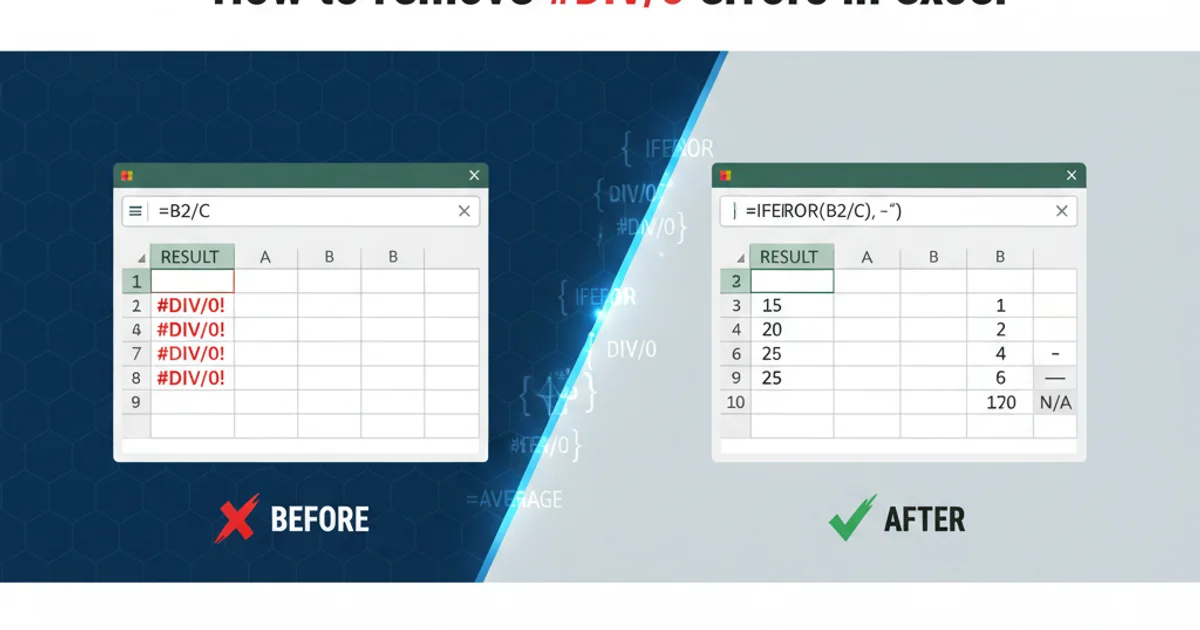How to remove #DIV/0 errors in excel
Categories:
Mastering Excel: Eliminating #DIV/0! Errors with IF, IFERROR, and IFNA

Learn how to effectively prevent and handle #DIV/0! errors in Excel using robust formulas like IF, IFERROR, and IFNA, ensuring clean and professional spreadsheets.
The #DIV/0! error is one of the most common and frustrating errors encountered in Microsoft Excel. It appears when a formula attempts to divide a number by zero, or by a cell that is empty or contains text, which Excel treats as zero in a division context. While the cause is straightforward, managing these errors to maintain clean, readable, and functional spreadsheets is crucial. This article will guide you through various methods to anticipate, prevent, and gracefully handle #DIV/0! errors using Excel's powerful conditional functions.
Understanding the #DIV/0! Error
Before diving into solutions, it's important to understand why #DIV/0! occurs. This error signals an impossible mathematical operation: division by zero. In Excel, this can happen in several scenarios:
- Direct division by zero:
=10/0 - Division by an empty cell: If cell
B2is empty,=A2/B2(whereA2contains a number) will result in#DIV/0!, because Excel treats an empty cell as0in arithmetic operations. - Division by a cell containing text: Similar to an empty cell, if
B2contains text,=A2/B2will also result in#DIV/0!. - Formulas that evaluate to zero: If a part of your formula calculates to zero, and that result is used as a divisor, it will trigger the error. For example,
=A2/(B2-C2)whereB2andC2are equal.
flowchart TD
A["Start Calculation (e.g., =A1/B1)"] --> B{"Is Divisor (B1) Zero, Empty, or Text?"}
B -- Yes --> C["Result: #DIV/0! Error"]
B -- No --> D["Perform Division"]
D --> E["Display Result"]
C --> F["End"]
E --> F["End"]
style C fill:#f9f,stroke:#333,stroke-width:2pxFlowchart illustrating the cause of a #DIV/0! error in Excel
Method 1: Using IF to Prevent #DIV/0!
The IF function is a versatile tool for conditional logic in Excel. You can use it to check if your divisor is zero or empty before performing the division. This is often the most explicit and controllable method.
The basic syntax is =IF(logical_test, value_if_true, value_if_false).
To prevent #DIV/0!, you'd check if the divisor is equal to zero. If it is, you can return a blank, a zero, or a custom message. If it's not zero, then perform the division.
=IF(B2=0, "", A2/B2)
Returns a blank if B2 is 0, otherwise performs the division.
=IF(B2=0, 0, A2/B2)
Returns 0 if B2 is 0, otherwise performs the division.
=IF(B2=0, "N/A", A2/B2)
Returns 'N/A' if B2 is 0, otherwise performs the division.
IF with text values, remember that Excel treats text as 0 in division. To handle this, you might need to combine IF with ISNUMBER or ISTEXT for more robust checks, or use IFERROR for a simpler approach.Method 2: Using IFERROR for Cleaner Error Handling
The IFERROR function is specifically designed to catch any error that a formula might produce and return a specified value instead. This is often a more concise solution than IF if you're only concerned with suppressing errors, not just DIV/0!.
The syntax is =IFERROR(value, value_if_error).
value is the formula you want to evaluate. value_if_error is what you want to display if the value formula results in an error (including #DIV/0!, #VALUE!, #REF!, etc.).
=IFERROR(A2/B2, "")
Returns a blank if A2/B2 results in any error, including #DIV/0!.
=IFERROR(A2/B2, 0)
Returns 0 if A2/B2 results in any error.
IFERROR is convenient, be cautious. It catches all errors. If your formula might produce other errors that you do want to see and debug, IFERROR will mask them. In such cases, IF might be a better choice for specific error handling.Method 3: Using IFNA (for #N/A errors, not #DIV/0!)
It's important to distinguish IFNA from IFERROR. The IFNA function specifically handles only the #N/A error (Not Available). It will not catch #DIV/0! errors. While not directly applicable to #DIV/0!, it's worth mentioning for completeness and to avoid confusion.
The syntax is =IFNA(value, value_if_na).
=IFNA(VLOOKUP(C1, A:B, 2, FALSE), "Not Found")
Returns 'Not Found' if VLOOKUP results in #N/A, otherwise returns the VLOOKUP result.
IFNA is for #N/A errors only, typically from functions like VLOOKUP, MATCH, or XLOOKUP when a lookup value isn't found. It will not help with #DIV/0!.Choosing the Right Method
The best method depends on your specific needs:
- Use
IFwhen: You want precise control over why an error is being handled (e.g., only if the divisor is zero, but not if there's a#VALUE!error elsewhere). It's good for debugging as it doesn't mask other potential issues. - Use
IFERRORwhen: You want a simple, catch-all solution for any error type, and you're confident that any error produced by the formula should be handled in the same way (e.g., display a blank or zero). This is often preferred for final presentation of data. - Avoid
IFNAfor#DIV/0!: This function is not designed for division errors.
1. Identify Potential Division by Zero
Review your formulas to locate any divisions where the denominator could potentially be zero, an empty cell, or text.
2. Select Your Error Handling Strategy
Decide whether you need specific error handling (using IF) or a general error suppression (using IFERROR).
3. Implement the Formula
Wrap your original division formula with the chosen error-handling function. For example, change =A2/B2 to =IF(B2=0, "", A2/B2) or =IFERROR(A2/B2, "").
4. Test Thoroughly
Test your updated formulas with various scenarios, including zero, empty, text, and valid numeric values in the divisor cell, to ensure they behave as expected.